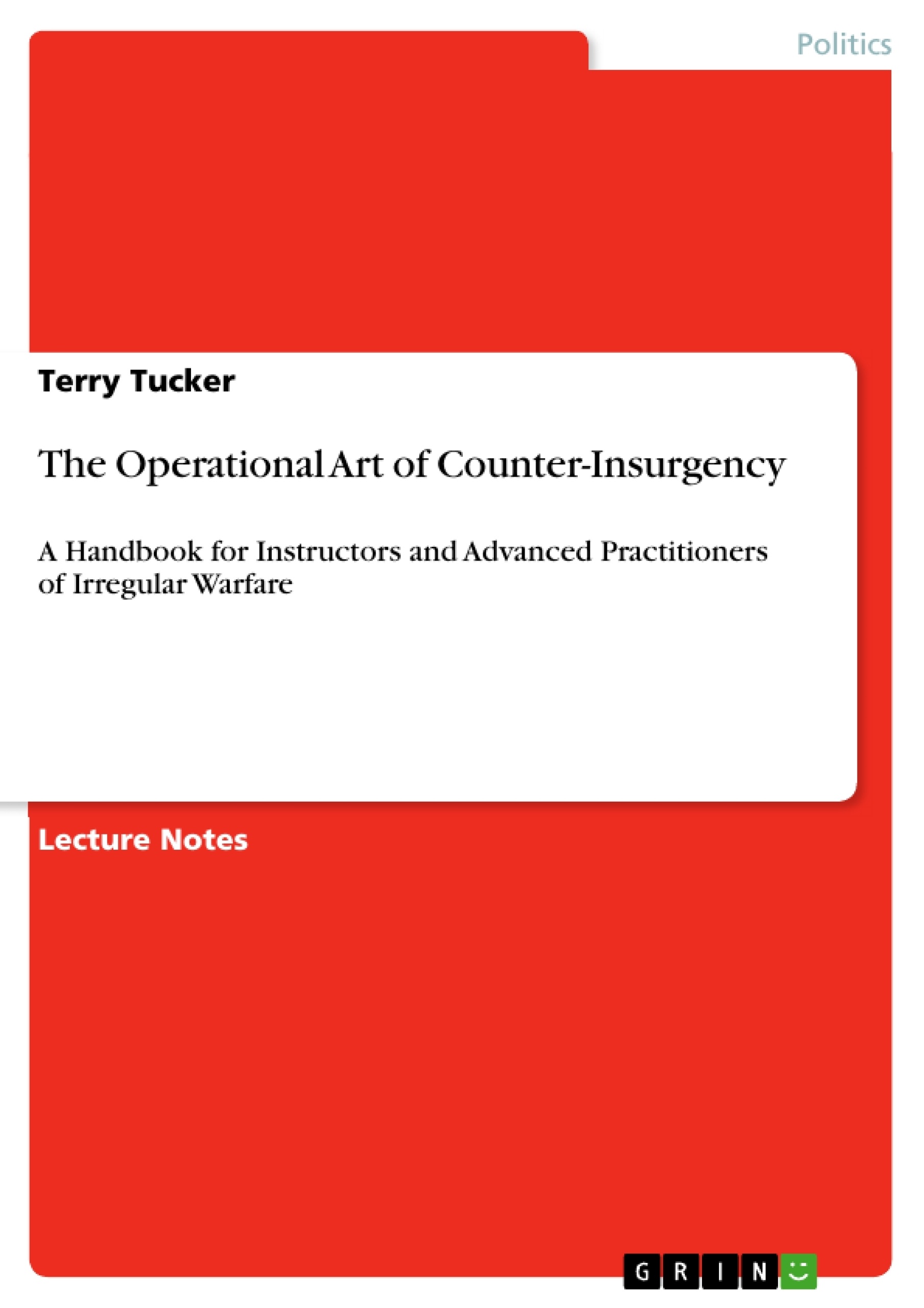The Operational Art of Counter-Insurgency:
A Handbook for Instructors and Advanced Practitioners of Irregular Warfare.
This hand book is primarily the Cliffs Notes for counterinsurgency and is meant to serve as a guide for experienced practioners. It contains outlines, key points, measures of effectiveness framed as questions and planning and design considerations.
There will be mini-seminars or lectures that precede some sections. My intent is to show both contemporary expereince and historical background. There are also a small series of lectures that I have given at the Counterinsurgency Training Center in Kabul and or at a remote training locations to Coalition partners.
When I put this together I made the assumption that those that would read this would have intermediate experience and knowledge of counterinsurgency and doctrine
Inhaltsverzeichnis (Table of Contents)
- Introduction
- Doctrinal Insurgency Fundamentals (FM 3-24, Counterinsurgency).
- Successful Practices and Convergence of Trends.
- Back to the Future: some commonalities with past insurgencies/counterinsurgencies and today's environment
Zielsetzung und Themenschwerpunkte (Objectives and Key Themes)
This handbook serves as a comprehensive guide for experienced practitioners of counterinsurgency, providing outlines and key points. It emphasizes understanding the historical context, doctrinal foundations, and current trends in irregular warfare.
- Understanding the historical context of counterinsurgency.
- Key doctrinal elements of counterinsurgency, particularly those related to social capital and the insurgency narrative.
- Successful counterinsurgency practices and the convergence of trends in the modern environment.
- The importance of understanding the political and social dimensions of counterinsurgency.
- The role of digital technology and social media in modern counterinsurgency.
Zusammenfassung der Kapitel (Chapter Summaries)
- Introduction: This chapter provides an overview of the handbook's purpose and target audience, highlighting its focus on providing key insights for experienced counterinsurgency practitioners. It emphasizes the importance of understanding historical context and doctrinal fundamentals.
- Doctrinal Insurgency Fundamentals (FM 3-24, Counterinsurgency): This chapter synthesizes and summarizes key historical and doctrinal elements of counterinsurgency, drawing from the foundational manuals FM 3-24 and FM 3-24.2. It emphasizes understanding the insurgent's motives, support network, narrative, and operational approach. The chapter also highlights the importance of analyzing the insurgency's dynamics, leadership, objectives, and environment.
- Successful Practices and Convergence of Trends: This chapter outlines key practices for successful counterinsurgency operations, focusing on the need for intelligence-driven operations, population-centric strategies, and secure area establishment. It also emphasizes the importance of host nation leadership, capacity building, and unity of effort among all involved actors. The chapter touches on the role of information operations and digital technologies in shaping the counterinsurgency narrative.
- Back to the Future: some commonalities with past insurgencies/counterinsurgencies and today's environment: This chapter explores historical parallels between past and present counterinsurgency campaigns. It highlights the enduring challenges of political complexities, social reengineering, and public perceptions. The chapter also emphasizes the importance of understanding the nuances of historical events and the need for avoiding simplistic historical comparisons. It touches on the role of "subaltern" resistance and the complexities of applying traditional warfare concepts to counterinsurgency.
Schlüsselwörter (Keywords)
This handbook focuses on the operational art of counterinsurgency, highlighting key concepts such as insurgency dynamics, doctrinal fundamentals, successful practices, historical context, and the influence of digital technologies. It explores themes related to social capital, population-centric approaches, information operations, and the importance of understanding the political and social dimensions of conflict.
- Quote paper
- Professor of History Terry Tucker (Author), 2011, The Operational Art of Counter-Insurgency, Munich, GRIN Verlag, https://www.grin.com/document/165135




